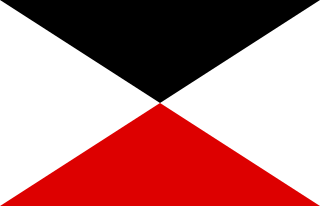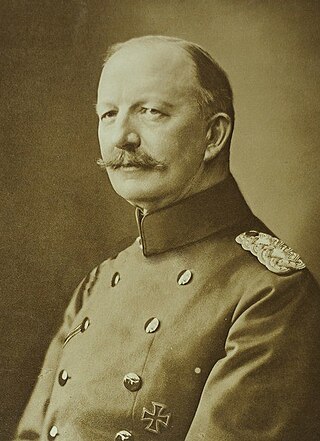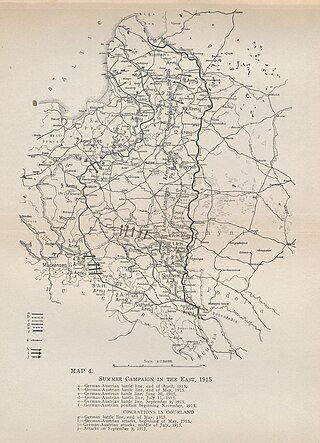Sources
This article includes a list of references, related reading, or external links, but its sources remain unclear because it lacks inline citations .(April 2016) |
The Army Group Hindenburg (German: Heeresgruppe Hindenburg) was an Army Group of the German Army, which operated in the Baltics against Russia between 5 August 1915 and 30 July 1916 during World War I, under command of Ober Ost Paul von Hindenburg.
It was renamed Army Group Eichhorn when Hermann von Eichhorn replaced Hindenburg on 3 July 1916 and remained in place until 30 March 1918.
This article includes a list of references, related reading, or external links, but its sources remain unclear because it lacks inline citations .(April 2016) |

Fritz Theodor Carl von Below was a Prussian general in the German Army during the First World War. He commanded troops during the Battle of the Somme, the Second Battle of the Aisne, and the German spring offensive in 1918.

Max Karl Wilhelm von Gallwitz was a German general from Breslau (Wrocław), Silesia, who served with distinction during World War I on both the Eastern and Western Fronts.

The XX Army Corps / XX AK was a corps level command of the German Army before and during World War I.

The Military Order of St. Henry was a military order of the Kingdom of Saxony, a member state of the German Empire. The order was the oldest military order of the states of the German Empire. It was founded on October 7, 1736 by Augustus III, King of Poland and Elector of Saxony. The order underwent several more revisions over the course of the 19th and early 20th centuries. It became obsolete with the fall of the Saxon monarchy in the wake of Germany's defeat in World War I.
This is the German Army order of battle on the outbreak of World War I in August 1914.

Günther Emanuel Graf von Kirchbach was a German Generaloberst who served during the First World War.

The 8th Army was an army level command of the German Army in World War I. It was formed on mobilization in August 1914 from the I Army Inspectorate. The army was dissolved on 29 September 1915, but reformed on 30 December 1915. It was finally disbanded in 1919 during demobilization after the war.

The Army of the Niemen was an army level command of the German Army in World War I.

The 1st Army was an army level command of the German Army in World War I. It was formed on mobilization in August 1914 from the VIII Army Inspectorate. The army was dissolved on 17 September 1915, but reformed on 19 July 1916 during the Battle of the Somme. It was finally disbanded in 1919 during demobilization after the war.

The 11th Army was an army level command of the German Army in World War I. It was formed in March 1915 in Kassel originally to serve on the Western Front but was transported to Galicia for service on the Eastern Front. The army was dissolved on 8 September 1915, but reformed on 23 September 1915 for the Serbian Campaign. It was finally dissolved on 7 January 1919.

The 12th Army was an army level command of the German Army in World War I formed in August 1915 by the redesignation of Armee-Gruppe Gallwitz. It served exclusively on the Eastern Front and was dissolved on 9 October 1916 when its commander, General der Infanterie Max von Fabeck, was transferred to 8th Army.

The 18th Army was an army level command of the German Army in World War I. It was formed against France on 27 December 1917 from the former Heeresgruppe Woyrsch command. It served exclusively on the Western Front and was dissolved on 2 January 1919.

The Guards Reserve Corps was a corps level command of the German Army in World War I.

Herrmann Gustav Karl Max von Fabeck was a Prussian military officer and a German General der Infantarie during World War I. He commanded the 13th Corps in the 5th Army and took part in the Race to the Sea on the Western Front and also commanded the new 11th Army on the Eastern Front. Subsequently, he commanded several German armies during the war until his evacuation from the front due to illness in 1916 and died on 16 December. A competent and highly decorated commander, von Fabeck is a recipient of the Pour le Mérite, Prussia's and Germany's highest military honor.

Rudolph Bodo Hans von Kirchbach was a Royal Saxon army officer who was a Generaloberst in the First World War and awarded the Pour le Mérite.

This is the order of battle for Operation Michael, part of the German Spring Offensive fought from 21 March to 5 April 1918 as one of the main engagements of the First World War. It was fought between mixed French, British and Dominion forces and the German Empire in the Somme region in northern France.

The leaders of the Central Powers of World War I were the political or military figures who commanded or supported the Central Powers.
The Army Group Mackensen which operated in Serbia between 18 September 1915 and 11 October 1916 during World War I under the command of field marshal Mackensen, was an Army Group of the German Army.
It was renamed on 11 October 1916 to Army Group Below and on 23 April 1917 to Army Group Scholtz, according to its new commander.
The Army Group German Crown Prince or Army Group B was an Army Group of the German Army, which operated on the Western Front under command of Wilhelm, German Crown Prince, between 1 August 1915 and 11 November 1918 during World War I.

The Bug-Narew Offensive from July 13 to August 27, 1915 was a major German victory during World War I on the Eastern Front. The Imperial German Army broke through 4 heavily fortified positions, inflicted defeats on superior enemy forces and pushed the Russian Army 300 km to the east, capturing 215,000 prisoners. But the German army also suffered relatively heavy casualties, about 30,000 killed and missing.